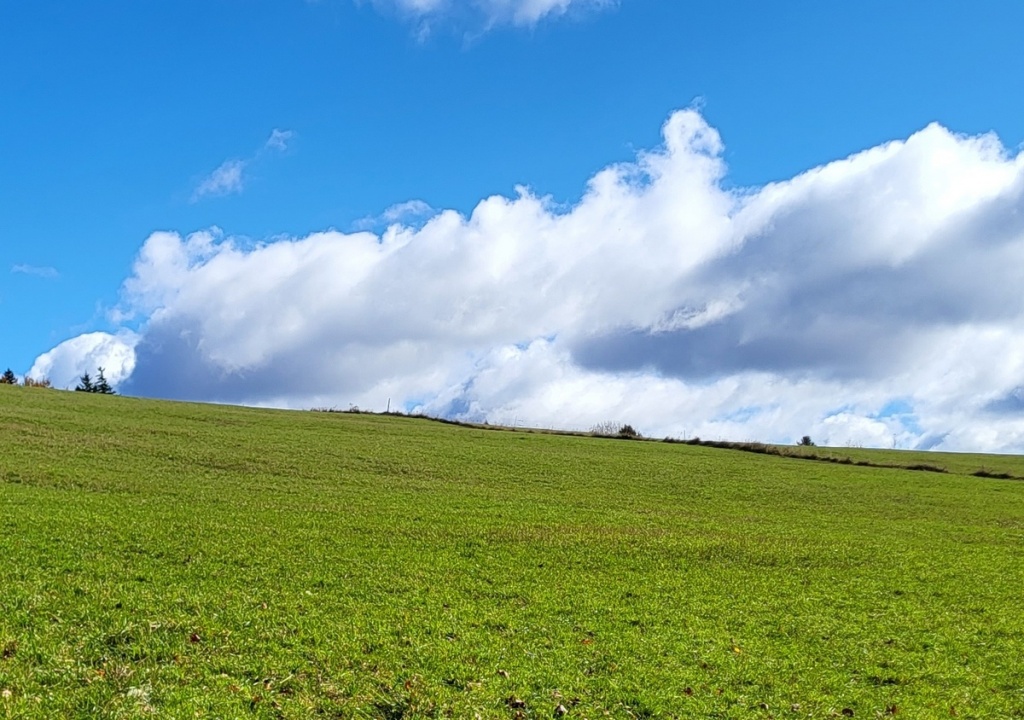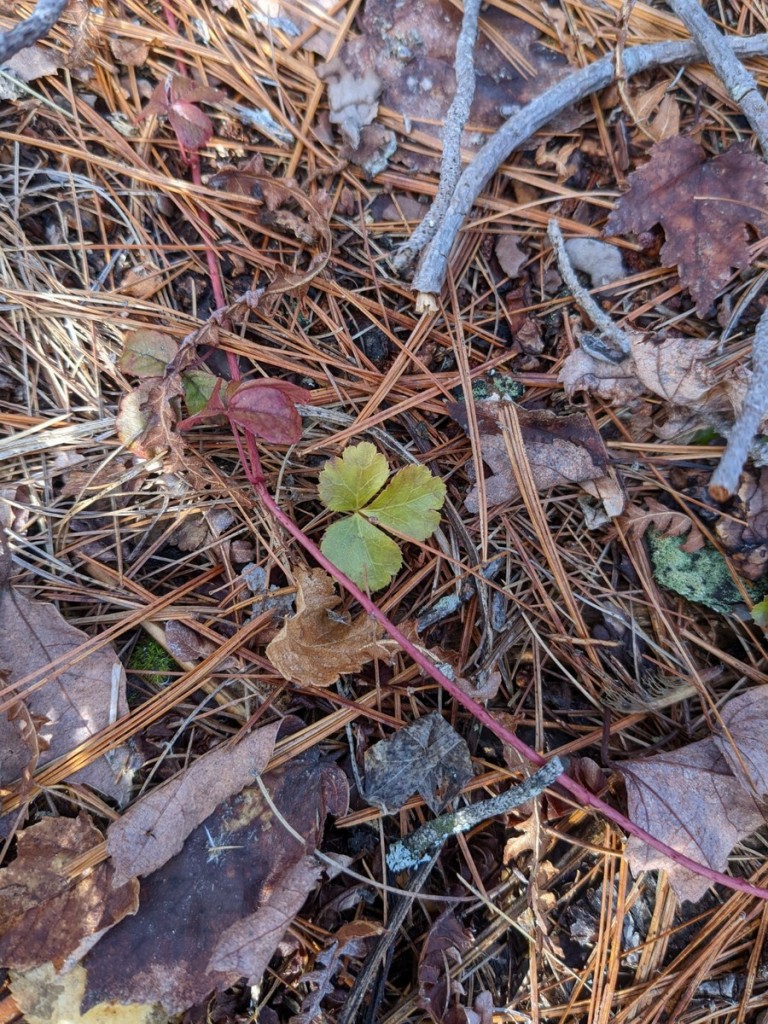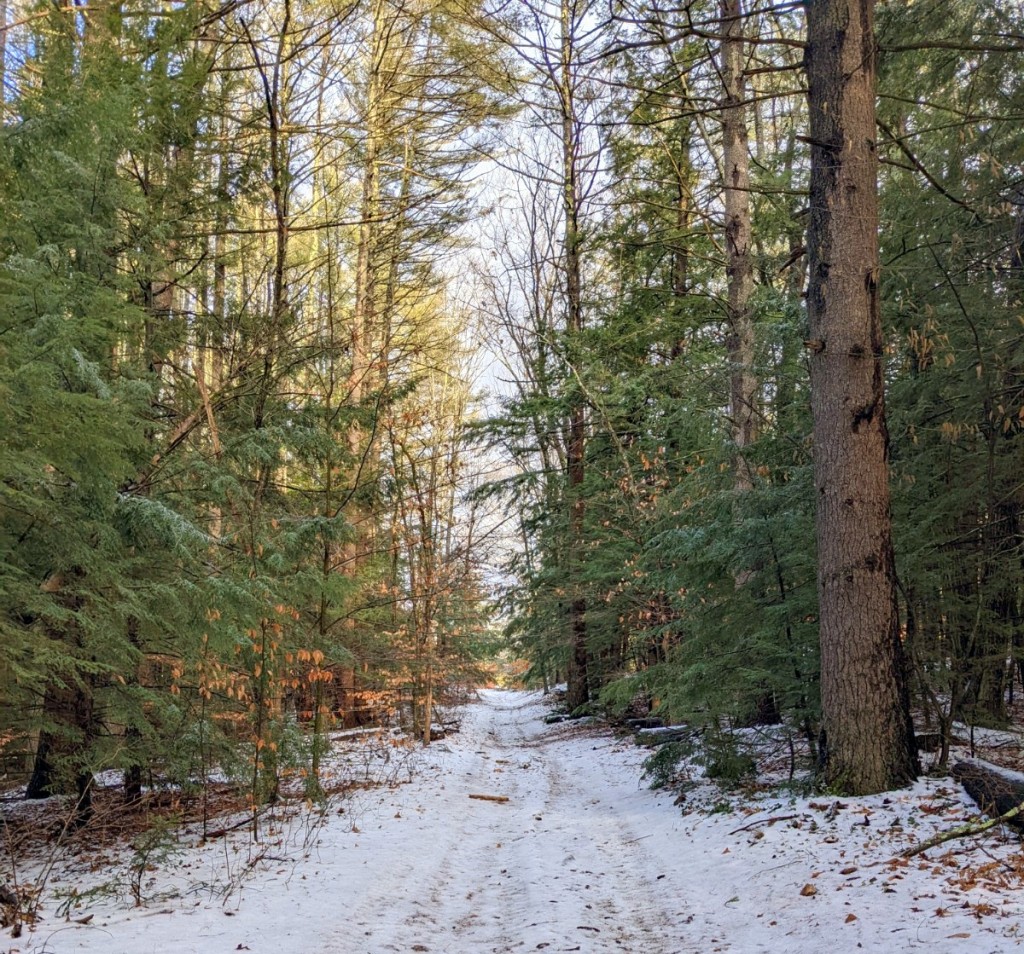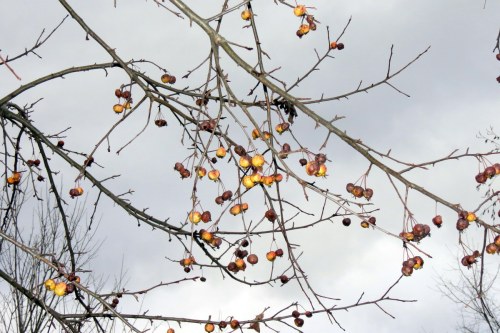
It isn’t just the trees that make fall so colorful, though you’d never know it by looking at this scene in the wetlands that I travel through. Everything plays a part, including the sky and water; it all just comes together all at once it seems, to make sure there is a beautiful end to the growing season.

I walked along the stream shore and found color everywhere; even in the water.

Here’s a closer look at that scene we saw in the first photo. The trees were mostly red maple but there might have been some American hornbeam and some ash trees mixed in. I’ve seen all three growing in the area. I stood here one day and heard a bird calling, so I looked up and saw an osprey soaring over the trees.

Oaks are just starting to show some color. They have a wide range, from yellow to orange to red and deep purple.

White ash also shows those same colors but this one was deep purple. I also saw one with orange leaves on this day as well. If you can imagine these trees colored this way when they’re 50-75 feet tall you get a good idea of the crazy quilt of colors in our forests.

This royal fern was beautiful, I thought. They often turn yellow in the fall so this one was a surprise.

Bracken ferns were a little less impressive but this one was still pretty in its way. All the various ferns are showing color right now.

Staghorn sumacs are often red like this one and also pumpkin orange this year.

I took this shot of ripe pokeweed berries a while ago but forgot I had taken it. The bright pink and deep purple go well together.

My favorite part of the pokeweed is the “flower” found on the back of each berry. Actually it is called a calyx but it does reveal what the pokeweed flower once looked like. The berries and all parts of this plant are toxic, but many birds and animals eat the berries. Native Americans used their red juice to decorate their horses and early colonial settlers dyed cloth with it. Some people, especially in the south, eat the spring shoots (called poke salad) despite the fact that the plant contains over one thousand different chemical compounds. Pokeweed is said to be the number one reason for calls to poison control centers.

When the sun shines and it warms up a bit dragonflies will still appaer. This was a red meadowhawk of some sort. I’ve read that there are many look alikes between red meadowhawks.

I’m seeing lots of shaggy inkcaps lately. As you can see if you look closely these mushrooms liquify, starting at the bottom of the bell shaped cap until the entire body has become a pool of black, ink like liquid. This liquid is full of this mushroom’s spores, and this is its method of spreading them.

I saw a wooly bear caterpillar hurrying across a road. According to the Old Farmer’s Almanac, the wider the brown stripe in the middle of the wooly bear caterpillar is, the milder the winter will be. “Between 1948 and 1956, Dr. C. H. Curran, curator of insects at the American Museum of Natural History in New York City, collected these caterpillars and counted the number of brown segments on each. Average brown-segment counts ranged from 5.3 to 5.6 out of the 13-segment total, meaning that the brown band took up more than a third of the woolly bear’s body. As those relatively high numbers suggested, the corresponding winters were milder than average.” The one in the photo has 5-6 brown segments and I believe that means that this particular caterpillar has 5-6 brown segments, and I believe that we will have winter.

“Parachutes,” made of white silk like fibers called floss help milkweed seeds float to new locations. They are commonly seen floating on the breeze at this time of year.

Now that the heat of summer is over dandelions are in bloom again. Odd that I never noticed that they disappeared in summer heat until I statrted doing this blog.

Knapweed is also still blooming sporadically here and there. I’ve also seen many garden plants like small leaved rhododendrons, roses, and even spirea blooming. This is actually a re-bloom for many of them.

Very few flowers show off their beautiful inner light as well as the purple morning glory. This plant is a true morning glory, not a bindweed, and if you let it go to seed in your garden you might be sorry that you ever saw it. It’s a beautiful thing and you can grow it in your garden as long as you’re willing to keep it dead headed so it doesn’t go to seed.

The pink garden turtleheads bloomed beautifully this year so I’m guessing, like their cousins the wild white turtleheads, the garden turtleheads like a lot of water. I’ve see the wild ones actually growing in water.

The turtleheads get their name from their supposed resemblance to a turtle and though my friend Dave saw a turtle before I even told him the name of the plant, I see fish sticking their tongues out.

Usually by this time of year oriental bittersweet has lost all of its leaves but this year they’re hanging on. They’re usually one of the first plants to change color; always a bright, lemon yellow.

And this is how Oriental bittersweet spreads, so if you bring some inside to decorate the holiday table throw it in the trash when the holidays are over, not in the woods. The birds do plenty of that.

When I was a gardener I always got questions about white pine trees at this time of year. People would see yellow needles on them and worry that they were dying but it’s just a naturla part of the process. Pines shed a lot of their oldest, interior needles that don’t see a lot of sunlight at this time of year. They simply don’t need them so they let them go. If they turn yellow and start dropping at other times of year then it might be time to call an arborist.

I had the idea last Friday (10/13) that I’d go over to Stoddard and climb Pitcher Mountain so I could show you some fall color from above. I hadn’t climbed for quite a while due to a clicking knee. It sort of “clicks” when I walk but there isn’t any pain and it hasn’t gotten worse, so off I went. It was a beautiful day.

It was nice to see the meadow again. I like it because it gives me a minimalistic view of life. For a few moments it’s just me, the sky and the earth, but on this day a huge looming cloud came up from the other side of the mountain so there were four. I was hoping I’d see some of the Scottish Highland Cattle that live here but there wasn’t a sign of them.

Up and up I climbed, stopping at this spot and turning around so I could get a shot of Mount Monadnock in the distance and the cloud shadows on the near hills. I’ve loved watching cloud shadows since I was a boy but eventually I climbed on and I was within sight of the summit when I fell. I don’t know what happened but I put my foot on a rock and lifted myself to move forward and suddenly I was falling backward. I think I simply stood up too straight, forgetting to lean into the steep hillside.
When I hit the ground I hit my head on a rock and there was lots of blood that seemed to be coming from everywhere on my scalp, so I shook myself off and headed back down the hillside. I drove to the Stoddard Firehouse but small towns have volunteer firemen so there was nobody there. Next I went to the Mill Village Country Store in Stoddard center. Judging by the looks on the faces I met there I must have been a sight, but the good folks at the store got me a chair, gave me a drink of water, and cleaned me up as best they could. They called one of the firemen, who came and looked me over and said the bleeding had stopped, so I drove myself to the Urgent Care Center in Keene where I had CAT scans and other tests. The verdict was scalp lacerations and concussion. I’ve been walking with a cane now and then as well because I must have also hit my upper left thigh pretty hard on a rock. I don’t know what if any impact this will have on future posts.
I’d like to thank the kind, helpful people at the Mill Village Country Store in Stoddard and the doctors, nurses, and support staff at the urgent care center at Cheshire Hospital in Keene. I might have made it through this without them but it was much more comforting to be in their company. Don’t believe everything you hear and read from the news; this country is still full of good, kind people who will drop everything in an instant to help those in need. Everyday heroes, in my estimation.
The events of the past day have proven to me that I am wholly alive, and that no matter what transpires from here on in, I have truly lived. ~Anonymous
Thanks for coming by.










































































































































































































